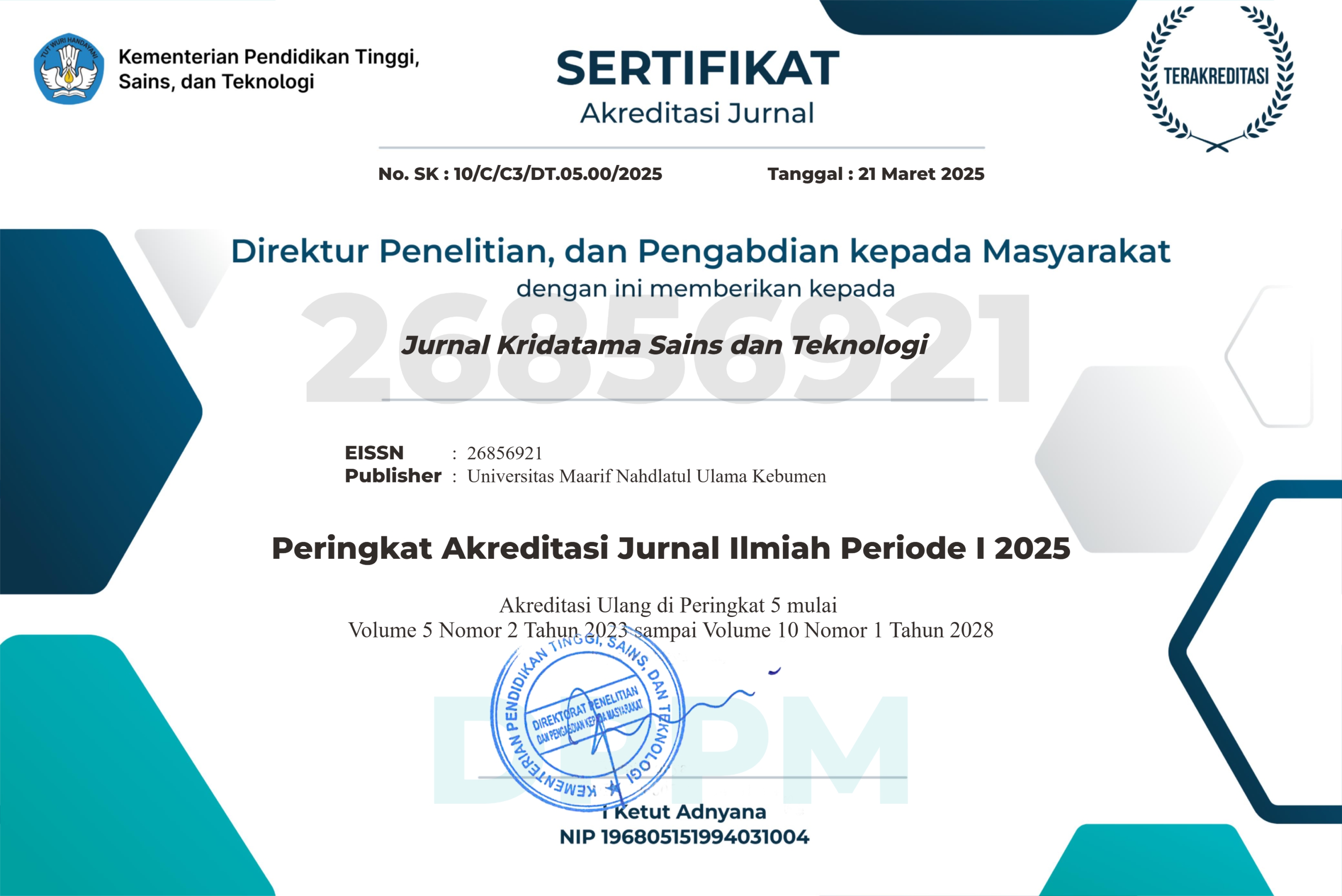Pembuatan Sensor Cahaya dengan Memanfaatkan LED dan LDR Berbasis Arduino Uno
DOI:
https://doi.org/10.53863/kst.v3i02.435Abstract
The recent technological developments are increasingly sophisticated and easy. So that the general public is easier to use. The development of this technology, then scientists are encouraged to create a new technologies. One that is often developed is the sensor. The aim of this research is to make a light sensor that utilizes LED and LDR as its main components. This light sensor can be used as alight measurement sensor from an optical material such as a fiber optic, or something else. The LDR performance testing as a detector is done by varying the light intensity of the hitting LDR. Test results show that the LDR sensitivity used is linear to the light intensity from the light source. Arduino uno is the main component of ADC. The ADC testing is done by varying the voltage on the arduino uno A0 analog pin from 0 V to 5 V in 0.1 V increments. In this research, the straight line equation y = 1.00532x + 0.00221 and R2 = 0.99988. From the this equation, it is known that the value of y is almost the same as the value of x and linearity is almost close to 1. This shows that the ADC output is almost the same as the input voltage.
Keywords: Sensor, LED, LDR, Arduino Uno
References
Beiser, A. (1981). Concepts of Modern Physics. New York: McGraw-Hill
Darmanto, T., Antonius, & Sutrisno, T. (2020). Penerapan sensor LDR dan sensor PIR pada prototype penerangan lampu rumah. Jurnal Inteksis, 7 (1), 72-79
Febtriko, A., & Sofian, T. (2016). Perancangan sistem pengamanan ruangan berbasis mikrokontroler (Arduino) dengan metode motion detection. jurnal teknologi dan Sistem Informasi UNIVRAB, 1(1), 1-7, ISSN: 2477-2062
Fidanboylu, K. & Efendio?lu, H. S. (2009). Fiber Optic Sensors and Their Applications. 5th International Advanced Technologies Symposium (IATS’09), 1-6
Khadir, A. (2013). Dasar pemrograman mikrokontroller Arduino. Jakarta: Elex Media Komputindo
Marzuki, I. (2019). Perancangan dan pembuatan sistem penyalaan lampu otomatis dalam ruangan berbasis Arduino menggunakan sensor gerak dan sensor cahaya. Jurnal Intake, 10 (1), 9-16, ISSN: 2580-6017
Novianti, K., Lubis, C., & Tony (2012). Perancangan Prototipe sistem penerangan otomatis ruangan berjendela berdasarkan intensitas cahaya. Seminar Nasional Teknologi Informasi, C1, 1-9
Pedrotti, F. L., & Pedrotti, L. S. (1987). Introduction to Optics. Englewood Cliffs, New Jersey: Prentice-Hall
Prasetyo, E. (2014). Fiber sensor tipe modulasi intensitas untuk aplikasi pengukuran beban kendaraan berjalan (weight in motion): fabrikasi dan analisis sinyal optik (Skripsi). UNS. Surakarta.
Syukron, A. A., Marzuki, A., & Setyawan, A. (2017). Fabrication and analysis signal optical fiber sensor based on bend loss for weight in motion applications. J. Phys.: Conf. Ser. 909 012033 doi: 10.1088/1742-6596/909/1/012033
Syukron, A. A., Marzuki, A., & Setyawan, A. (2017). Analysis of bend loss in loaded fiber coil for a circular and an elliptical shape. J. Phys.: Conf. Ser. 909 012014 doi: 10.1088/1742-6596/909/1/012014
Wardoyo, E. K. (2020). Perancangan alat pendeteksi gerakan menggunakan sensor infrared berbasis Arduino uno dengan tampilan sms (Skripsi). USU. Medan.
Downloads
Published
How to Cite
Issue
Section
License
Copyright (c) 2021 Ahmad Aftah Syukron,Isnaini Lilis Elviyanti

This work is licensed under a Creative Commons Attribution-NonCommercial-NoDerivatives 4.0 International License.
Authors retain copyright and grant the journal right of first publication with the work simultaneously licensed under a Creative Commons Attribution-ShareAlike 4.0 International License that allows others to share the work with an acknowledgment of the work’s authorship and initial publication in this journal

















